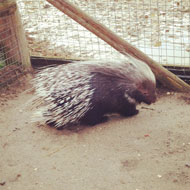Prickly procedure for the Animal Health Trust

Mwoiba has been reunited with her mate after the successful procedure to restore her vision.
Zoo staff at Chessington World of Adventures Resort in Surrey first noticed that something was amiss with 10-year-old porcupine Mwoiba (pictured) when her eye became blurry.
The resort called upon the AHT in Suffolk for advice, and Mwoiba was admitted to be investigated for a suspected cataract.
To determine the cause of the problem, Mwoiba was anaesthetised and intubated for examination. This difficult procedure was made no easier by the prickly patient, who was in no mood to be investigated.
Claudia Hartley, head of small animal opthamology at AHT, said: “It was instantly clear that Mwoiba did not want to be examined. She continually gave a defiant rattle of her spines as a warning to us all to 'watch our step'."
Once successfully anaesthetised, Claudia was able to perform an ocular ultrasound – a procedure that pinpointed the exact damage to Mwoiba’s eye.
“We could see that she had suffered a severe trauma to her left eye,” explained Claudia. “We suspected she had incurred this whilst 'arguing' with her housemate, and had suffered a perforating trauma (perhaps from one of the threatening spines).”
Luckily for Mwoiba, her retina had not become detached during the scuffle, as this finding would have meant that it was impossible to restore her sight. Claudia was able to perform surgery to remove the cataract, successfully restoring her vision.
Now, seven weeks since the surgery, Mwoiba has been reintroduced to her spiny companion and is slowly weaning on a dose of medications.
Commenting on her progress, Claudia said: “We’re thrilled to see that vision has returned to Mwoiba’s left eye again, and we hear from her handlers that she is back in good health. She is a real character, and we at the AHT are all thrilled to have been able to help her see clearly again.”
Image courtesy of the Animal Health Trust.



 The RCVS has announced a new version of its 1CPD mobile app, with enhanced features for veterinary surgeons and veterinary nurses to record their continuing professional development.
The RCVS has announced a new version of its 1CPD mobile app, with enhanced features for veterinary surgeons and veterinary nurses to record their continuing professional development.